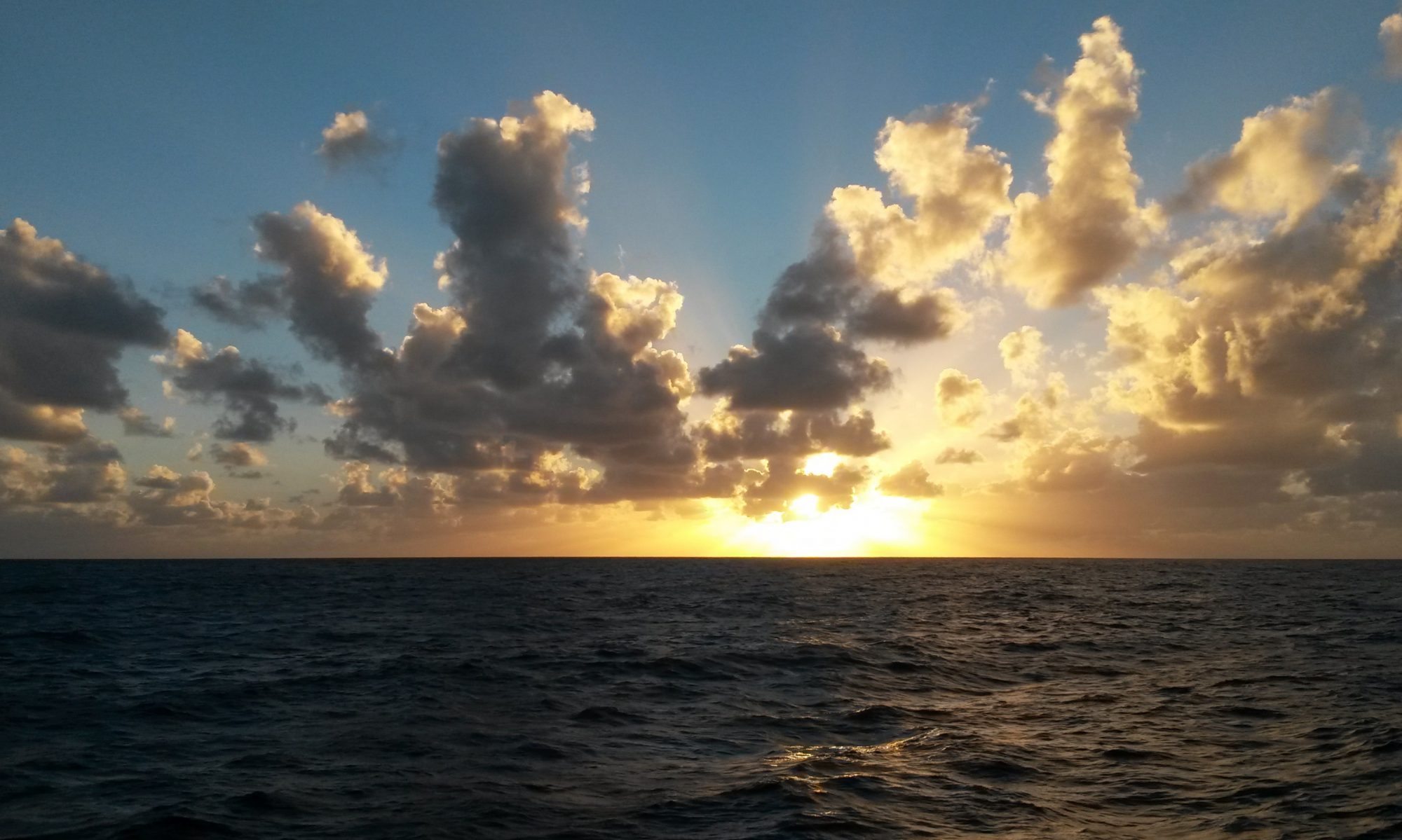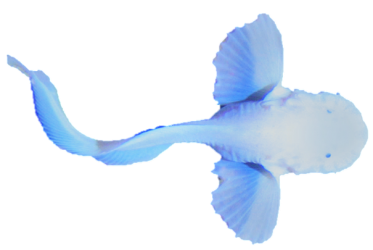This educational material was created for the Deep Ocean Education Project through the support of National Science Foundation grant IOS #2407551 to PIs Gerringer & Daane.
The deepest parts of the ocean are called the hadal zone, named for the Greek underworld. But these incredible habitats are anything but scary! Deep-sea trenches are home to amazing organisms such as hadal snailfishes, supergiant amphipods, tree-like stalked crinoids, sea cucumbers, and giant single-celled organisms called xenophyophores. Life in the trenches requires specialized adaptation to extreme environmental conditions, including high pressure, cold temperature, and lack of sunlight. Although deep-sea trenches may seem remote and otherworldly, pollution and other human activities are already impacting these unique ecosystems. Many organisms that live in deep-sea trenches are only found in the hadal zone, making these important habitats to study and to protect. Let’s dive deeper and explore the hadal zone!
How deep is the ocean?
Although the deep sea is out of sight and often out of mind, most of our planet is actually deep ocean. The oceans are very deep, on average 3,682 meters or 12,080 feet! That’s more than 2.2 miles down. Some parts of the ocean get even deeper than that. The deepest ocean zone is called the hadal zone, depths greater than 6000 meters or 19,685 feet.
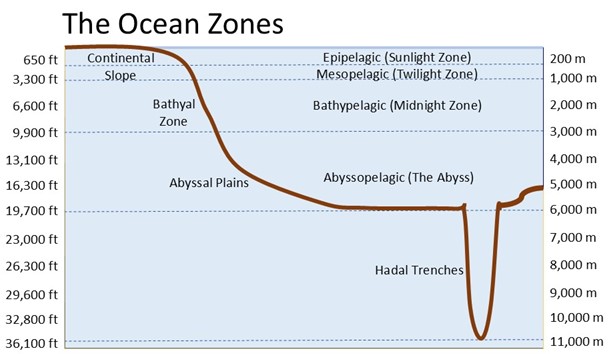
The deepest part of the ocean is in the Mariana Trench in the western Pacific, which has a maximum depth of 10,984 meters or 36,037 feet. This deepest point is called Challenger Deep, named for the HMS Challenger expedition that discovered the trench in the 1870s. 36,000 feet is a long way down, you may recognize this as a common cruising altitude for commercial aircraft! Check out the How deep is the ocean? activity for more!
At almost seven miles deep, the pressures at the deepest ocean depths are high, reaching ~15,000 pounds per square inch. This pressure is about the equivalent of an elephant standing on top of your thumb! Despite these high pressures and conditions that we humans think of as being harsh, to many organisms, deep-sea trenches are just home.
Why are trenches so deep?
The hadal zone is made up of multiple habitats that extend from depths 6,000 to nearly 11,000 meters. Most of these hadal habitats are trenches that form via subduction, an important geological process where one tectonic plate slides under another. Many important geological features form at these and other types of plate boundaries. Subduction is driven by the formation of new crust at spreading centers and by sinking plates being drawn back into the earth, a process called slab pull. For a deeper dive into the geology of why Challenger Deep in the Mariana Trench is so deep, see Fryer et al., 2003.
There are also a few other hadal sites that are deep depressions called troughs or fracture zones called trench faults. A full list of the 27 hadal subduction trenches, 13 hadal troughs, and seven trench faults, with their locations and depths can be found in Stewart & Jamieson, 2018.
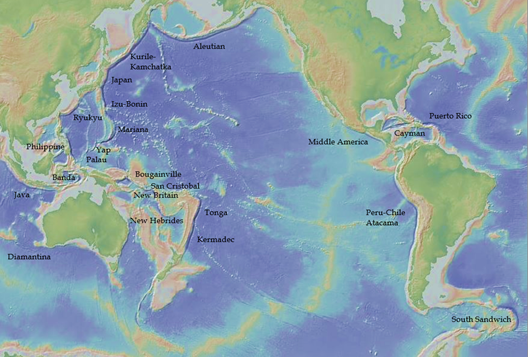
How do we study deep-sea trenches?
Getting to the bottom of the oceans and back is challenging. Many advances in deep-sea science come from advances in engineering and technology, particularly in the hadal zone.
Early studies of deep-sea trenches relied on trawling with nets. Although these trawl samples advanced understanding of the biology and geology of the hadal zone, towing a net at these depths is very difficult. The cable that holds the net or other towed equipment needs to be miles long to reach these depths. With that much wire, sometimes the cable can actually snap under its own weight. Because of these challenges, free vehicle landers are an important tool for deep-sea research. These landers are not connected to the ship. The team will deploy the lander with a heavy ballast weight that takes the lander to the seafloor. It can take several hours for the lander to make the journey! Landers can stay on the seafloor for a few hours or even a few years, depending on the study. These can be equipped with cameras, temperature sensors, bottles that collect water, coring devices that collect sediment, animal traps, and more to understand the deep-sea environment. Using an acoustic signal from the ship or a timed release, the lander will drop the ballast weight when it’s time to come back to the surface. Floatation brings the lander back up to the surface, and the research team will find it, bring it back onto the ship, and collect the data.
Other trench research is done by moving underwater robots that can be controlled from the ship, known as remotely operated vehicles, or ROVs. These ROVs don’t have people in them, the pilots and scientists work on a research ship and communicate with the vehicle through a long wire. ROVs can collect video, water samples, rocks, and more from the seafloor. Although challenging at hadal depths, there are also a few full-ocean-depth capable submarines that carry humans to deep-sea trenches for science and exploration.
All research methods have advantages and disadvantages, so a combination of tools helps scientists get the most complete understanding of an ecosystem.
Life in the trenches
Deep-sea trenches are home to an incredible range of organisms, from microbes to large animals like bony fishes. These animals are adapted to the high pressures, cold temperatures, and lack of sunlight found in the hadal zone. Hadal ecosystems are distinct from those on the abyssal plains, there are shifts in community structure that occur around 6,000 meters. Even within the hadal zone, we see patterns of depth zonation, with some species found at the upper parts of the trench and other species living to full-ocean depth.
Journey through the hadal zone through this video to meet some of the amazing species that live in deep-sea trenches!
Hadal Highlights Video: Schmidt Ocean Institute In the upper hadal zone, depths ~6,000–8,000 meters, trench ecosystems are home to a diversity of organisms, including:
Hadal Snailfishes
- These little pink fishes are the ocean’s deepest-living vertebrates, able to survive at depths greater than 8,000 meters! Although we often think of deep-sea environments as harsh, the fishes that live in the hadal zone look fragile, with transparent pinkish or white skin and soft, scaleless bodies. These fishes are adapted to the trench environment from their genomes to the whole organism, with proteins that function best at high pressure, a strong second set of jaws in the back of the throat for feeding on hadal crustacean amphipods, and potentially faster lifespans to live in the high-disturbance environment of these subduction zones. For more on hadal snailfishes, including additional video, check out:
- https://www.youtube.com/playlist?list=PLZVt5hoFXeh-oxi-lzT7eLTnItqd9G0CS
Rattails, Cutthroat Eels, & Cusk Eels
- Some fishes that are commonly seen on the abyssal plains also descend into hadal depths. Three examples of these are the rattails (family Macrouridae), cutthroat eels (family Synaphobranchidae), and cusk eels (family Ophidiidae). Many deep-sea fishes have evolved elongated bodies, like these three eel-like groups, which is thought to aid energy-efficient swimming in this food-limited environment. Many of these species are often or sometimes scavengers, feeding on carrion that has fallen from the surface oceans.
- Videos of shallower-living cutthroat eels in the genus llyophis at a shallower depth from NOAA Ocean Exploration: More on the rattails and other members of the Order Gadiformes:More on rattails and cusk eels:
- More on abyssal fishes, including the families described here:

Microcomputed tomography (micro-CT) scan of the skull of Dysomma polycatadon, a cutthroat eel in the family Synaphobranchidae. While this species does not inhabit hadal depths, some of its relatives do. Cutthroat eels often have very interesting jaw morphology, for example, this fish that has three large teeth right in the center of the roof of the mouth! Photo by Mackenzie Gerringer.
Decapod Shrimp
- There are more than 15,000 species of shrimp, crabs, and lobsters alive today, forming the order Decapoda. In the deep sea, decapods are also diverse. Decapods have been seen in the upper parts of the hadal zone, living to depths of at least 7,700 meters, or 25,263 feet. These beautiful deep-sea shrimp can be large, several inches in body length, swimming with a mesmerizing gait by paddling multiple pairs of legs called pleopods.
- More on decapods:
- Some decapods can even secrete bioluminescent light! https://oceanexplorer.noaa.gov/explorations/15biolum/logs/july23/july23.html
- More on decapods:
Crinoids
- Crinoids, sometimes called ‘sea lilies,’ may look a little like plants, but they are actually animals! These are in a group called the Echinodermata, from the Greek for ‘spiky skin’, which also includes sea urchins, sea stars, sand dollars, and sea cucumbers. Crinoids have been found in hadal trenches to depths of more than 9,000 m!
At the deepest hadal depths, from ~8,000–11,000 meters,
Xenophyophores
- In addition to hosting many animals and a wide variety of microbes, deep-sea trenches are also home to amazing, single-celled organisms called xenophyophores, which can be surprisingly large, sometimes more than 4 inches in diameter! These organisms are part of an interesting and understudied phylum called the Foraminifera, which are diverse and play important roles in both in the water column and on the seafloor. In deep-sea trenches, some of these xenophyophores build ornate houses and collect sediment. There is still much to learn about these incredible organisms and their role in deep-sea ecosystems.
- Xenophyophores in the Mariana Trench: https://ucsdnews.ucsd.edu/pressrelease/researchers_identify_mysterious_life_forms_in_the_extreme_deep_sea
Amphipods
- Amphipods are crustaceans that are typically small and are found across marine habitats. In deep-sea trenches, amphipods are some of the most abundant organisms. These crustaceans are well-adapted to living in deep-sea trenches, capable of feeding on detritus and sunken dead organisms, and these crustaceans are well-adapted to survive under high pressures. There are multiple species of amphipods that live in deep-sea trenches. Unfortunately, these animals are already being impacted by human activities such as pollution, with a recent study finding high quantities of microplastics present in these ultra-deep-living species. While small amphipods are found at all ocean depths, in the shallower parts of trenches, around depths of 6000 m, there are very large amphipods called supergiant amphipods, that can grow to be more than 11 inches long! These supergiant amphipods can feed on carrion for long periods of time, undisturbed by other organisms due to their large size.
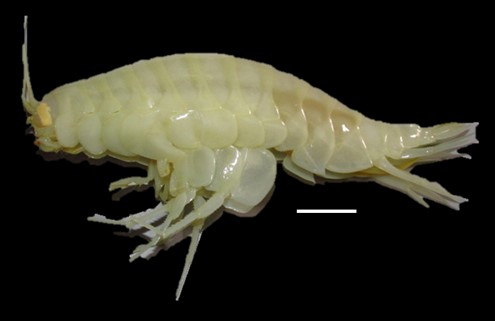
Sea cucumbers
- In the deepest parts of the hadal zone, sea cucumbers can also be found. These echinoderms feed on mud, gaining nutrients from the microbial communities that live in the sediment and from organic material that has sunken and settled on the seafloor. Sea cucumbers are highly diverse in the deep-sea. Some abyssal species can even swim!
- Sea cucumber diversity in the deep sea:
- https://nautiluslive.org/video/2014/08/27/sea-cucumbers-deep
- Sea cucumber diversity in the deep sea:
Scale worms
- Other animals you may find living in the deepest parts of the hadal zone are called scale worms, recognizable by their segmented bodies and hair-like projections. Many scale worms are great swimmers, using their paddle-like legs to travel through the water with a serpentine motion.
- Shallower-living deep-sea scale worm video: https://oceanexplorer.noaa.gov/multimedia/video-shorts/ex1711-worm.html
An international history of exploration
Trench exploration has a long international history involving many scientists and collaborations. The first hadal trench samples were collected by the British HMS Challenger expedition in the 1870s. The first systematic investigations of hadal life were conducted in the 1950s by the Danish RV Galathea expedition and Soviet RV Vityaz expedition. The first people to dive to Challenger Deep were Swiss oceanographer Jacques Piccard and American Navy officer Don Walsh in the submersible Trieste in 1960. In the 1960s and 70s, multiple hadal submersible dives were conducted by the French submersible Archimède, which further advanced hadal science. Pioneering hadal research has continued since that time by many countries and scientists, including by the first remotely operated vehicle to be capable of full-ocean depth work, Kaiko, built by the Japan Agency for Marine-Earth Science and Technology. Systematic surveys of hadal life have continued through multiple partnerships, including the Scottish-Japanese collaboration HADEEP (HADal Environments and Educational Program), the US-New Zealand-UK collaboration HADES (Hadal Ecosystems Studies), surveys by the Danish Center for Hadal Research, the Minderoo Deep-Sea Research Centre in Australia, the Chinese submersible HOV Fendouzhe and the Mariana Trench Environment and Ecology Research Project, and the German-Russian AleutBio program. Deep-sea exploration requires cross-disciplinary collaboration and benefits from international partnerships.
Trenches are important to study and to protect
Deep-sea trenches are one of the planet’s least explored habitats, making these ecosystems sites of wonder and scientific curiosity. There are many reasons to explore and protect the hadal zone. Deep-sea trenches are home to many species that are new to science, including many species that only live in one or more specific trench, making them endemic to the hadal zone. Additionally, deep-sea trenches play a significant role in the carbon cycle, contributing to carbon sequestration.
The very environmental conditions that make deep-sea trenches seem harsh to us humans have led to an incredible array of adaptations that inspire both our curiosity and our technology. The hadal zone makes up the deepest half of the ocean, with pressures reaching 1000 times what we experience at atmospheric pressure. These high pressures have led to evolutionary innovations that may also inspire engineering. For example, the special adaptations that animals use to stabilize their proteins under high pressure are inspiring the development of new pharmaceuticals to treat conditions including glaucoma. Humans also use high pressure for applications like food processing. If we understand how pressure affects biochemistry, we can design ways to better sterilize or prepare food. Research on deep-sea ecosystems can serve as an important source of bioinspiration, allowing us to model new technologies based on nature’s solutions.
Studying extreme environments on our own planet can also open important doors to searching for and understanding potential life on other worlds. Astrobiologists are often interested in studying life under extreme conditions such as the high pressures and cold temperatures of the hadal zone to understand what adaptations and characteristics life beyond Earth may have and how this life might be detected.
Although trenches are some of our planet’s more remote habitats, the hadal zone is already impacted by human activities. Multiple examples of trash have been documented in trenches, including in Challenger Deep, the ocean’s deepest site. Microplastics and other pollutants like PCBs (Polychlorinated Biphenyls) have been found in hadal animals in disturbingly high concentrations. Scientists even named a newly described species of hadal crustacean Eurythenes plasticus, after the high concentration of microplastics found in the animal. Although we often think of trenches as being remote and otherworldly, these habitats are already impacted by human activities and require understanding and effective management.
Additional Resources on Deep-Sea Trenches
- U.S. Fish & Wildlife Service: Mariana Trench Marine National Monument
- Mariana Trench National Monument Information: NOAA
- Deep Ocean Education Project: Marianas Trench Marine National Monument explained (Video)
- Video: Voyage to the Mariana Trench National Monument
- Schmidt Ocean Institute: Exploring the Mariana Trench Expedition
- Schmidt Ocean Institute: Expanding Mariana Trench Perspectives: Getting into the Zone
- Schmidt Ocean Institute: Exploring the Hadal Zone: The Little Pink Fish in the Deep
- Schmidt Ocean Institute: Exploring the Hadal Zone: The Deepest Living Animals
- Schmidt Ocean Institute: Exploring the Hadal Zone: Studying the Ecology and Geology of the Mariana Trench – The Deepest Place on Earth
- Nautilus Live: Technology Feature Hadal Water Column Profiler
- The Hadal Zone: Life in the Deepest Oceans, Alan Jamieson, Cambridge University Press
- Hadal Animal Photos by Paul Yancey
